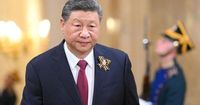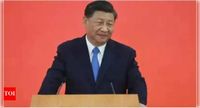Chinese President Xi Jinping made a rare and high-profile visit to Lhasa on August 20, 2025, marking the 60th anniversary of the founding of the Tibet Autonomous Region. The occasion, saturated with symbolism and political messaging, underscored Beijing’s determination to maintain its grip on the Himalayan territory—one that has remained fraught with tension, controversy, and international scrutiny for decades.
Xi’s arrival in Tibet’s regional capital was met with orchestrated fanfare. According to Xinhua News Agency, he "received a warm welcome from people of various ethnic groups who waved bouquets of flowers and danced to joyful rhythms." The official narrative emphasized unity and prosperity, with Xi urging the construction of a “modern socialist” Tibet that is “united, prosperous, civilized, harmonious, and beautiful.”
The timing of Xi’s visit was no accident. It came precisely six decades after the Communist Party, under Mao Zedong, designated Tibet as an autonomous region in 1965, following the People’s Liberation Army’s occupation in 1951. This move—meant, at least on paper, to grant ethnic minorities like the Tibetans a greater say in policy and religious freedom—remains sharply contested. International human rights groups and Tibetan exiles routinely describe China’s rule as “oppressive,” a charge Beijing vehemently rejects.
In his address to senior Tibetan officials, Xi doubled down on the Party’s priorities. "To govern, stabilise and develop Tibet, the first thing is to maintain political stability, social stability, ethnic unity and religious harmony," state media quoted him as saying. This emphasis on stability and unity is hardly new, but Xi’s repetition of these themes this week signals Beijing’s ongoing anxiety about unrest in a region with a long history of resistance.
Indeed, Tibet’s story since 1951 has been marked by decades of political repression, the demolition of Buddhist monasteries, and the imprisonment of monks. The region’s distinct culture, language, and religion have often been at odds with the Communist Party’s vision. In recent years, the government has accelerated the migration of majority Han Chinese into Tibet, virtually closed the region to foreign journalists and observers, and removed Tibetan children from their families to boarding schools where they are taught in Mandarin. Expressions of political or cultural identity outside of Party control are swiftly suppressed.
One especially sensitive issue is the reincarnation of the Dalai Lama, Tibetan Buddhism’s highest spiritual authority. China insists it has the right to appoint the next Dalai Lama, a position that has drawn global condemnation and deepened Tibetan resentment. The current Dalai Lama, now 90, has lived in self-imposed exile in India since fleeing Chinese rule after a failed uprising in 1959. During Xi’s visit, China reiterated its claim to decide the succession, sparking protests by exiled Tibetans in India—particularly as Chinese Foreign Minister Wang Yi visited the country at the same time.
Critics, including international rights organizations, say that repression in Tibet has only intensified since the crushing of widespread anti-government protests in 2008. That year, monks and nuns led demonstrations that were met with harsh crackdowns; a wave of self-immolations followed in the years after. According to Reuters, Xi’s previous visit to Tibet in July 2021 was widely interpreted as a show of confidence that the Communist Party had finally established order after decades of unrest.
Beijing, for its part, touts its record on economic development, poverty reduction, and infrastructure in Tibet. The government points to new roads, railways, and modern amenities as evidence of progress. But for many Tibetans and their advocates, these changes come at the cost of cultural erasure and political disenfranchisement. The region remains largely closed to independent reporting, making it difficult to verify the government’s claims or the extent of popular support for its policies.
Tibet’s strategic importance to China cannot be overstated. The region shares a long, contested border with India—a flashpoint that has seen military clashes in recent years, most notably a deadly skirmish in 2020. During Xi’s visit, China’s top diplomat Wang Yi was in India, where both countries pledged to rebuild ties strained by the border dispute. The timing of these parallel visits did not go unnoticed by observers, who speculated about their diplomatic choreography.
Another area of contention is Tibet’s abundant natural resources, particularly its immense hydropower potential. China’s latest mega hydropower project in Tibet has unsettled India, which relies on downstream river flows. Xi described the project as something that must be "vigorously" pursued for China’s carbon reduction goals and to protect Asia’s "water tower," a term for the region’s crucial role in feeding major rivers across the continent. India, meanwhile, has voiced concerns about water security and the environmental impact of such projects.
Xi was accompanied by senior Communist Party officials, including Wang Huning and Cai Qi, the party’s fourth and fifth-ranked leaders. Their presence underscored the political weight of the occasion. The last time a Chinese leader visited Tibet before Xi’s 2021 and 2025 trips was in 1990, when Jiang Zemin made the journey for a similar anniversary celebration.
The official Chinese narrative insists that Tibet has been an integral part of its territory for centuries. Yet, many Tibetans maintain they were effectively independent for much of that time, governed by their Buddhist theocracy. This fundamental disagreement continues to fuel tensions, both within Tibet and in the international arena.
While Beijing projects confidence in its control over Tibet, the region remains a crucible of unresolved historical grievances, cultural resistance, and geopolitical intrigue. The 60th anniversary celebrations, with their pageantry and official pronouncements, may showcase the Party’s vision of a harmonious and modern Tibet. But for many, the underlying questions of autonomy, identity, and justice remain as pressing as ever.
As Tibet enters its seventh decade under Chinese rule, the world’s eyes remain fixed on this high-altitude crossroads—where the past is never far from the present, and the future is anything but certain.



